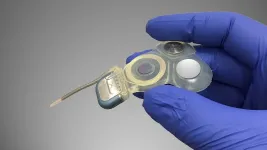(Press-News.org) Irvine, CA - February 11, 2021 - Subconsciously, our bodies keep time for us through an ancient means - the circadian clock. A new University of California, Irvine-led article reviews how the clock controls various aspects of homeostasis, and how organs coordinate their function over the course of a day.
"What is fascinating is that nearly every cell that makes up our organs has its own clock, and thus timing is a crucial aspect of biology," said Kevin B. Koronowski, PhD, lead author and a postdoctoral fellow in Biological Chemistry at the UCI School of Medicine. "Understanding how daily timing is integrated with function across organs has implications for human health, as disruption of the clock and circadian rhythms can be both a cause and effect of diseases from diabetes to cancer."
The circadian clock generates a ~24 hour rhythm that controls behavior, hormones, the immune system and metabolism. Using human cells and mice, researchers from the Paolo Sassone-Corsi Laboratory at UCI's Center for Epigenetics and Metabolism aim to uncover the physiological circuits, for example between the brain and liver, whereby biological clocks achieve coherence. Their work, titled, "Communicating clocks shape circadian homeostasis," was published today in Science.
Circadian clocks align internal processes with external time, which enables diverse lifeforms to anticipate daily environmental changes such as the light-dark cycle. In complex organisms, clock function starts with the genetically encoded molecular clock or oscillator within each cell and builds upward anatomically into an organism-wide system. Circadian misalignment, often imposed in modern society, can disrupt this system and induce adverse effects on health if prolonged.
"Strategies to tune our clocks and boost rhythms have been promising in pre-clinical studies, which illustrates the importance of unraveling this aspect of our biology and unlocking the potential it holds for treatments and medicines of the future," said Koronowski.
Without electrical light, high-speed travel, constant food availability and around the clock work-life schedules, our ancestors' clocks were in constant harmony with the environment. However, due to these pressures of modern society, aligning our internal time with geophysical time has become a challenge in today's world. Chronic misalignment - when eating and sleeping patterns conflict with the natural light-dark cycle - is associated with an increased risk of metabolic syndrome, cardiovascular disease, neurological conditions, and cancer. A large portion of the global workforce has atypical hours and may be particularly vulnerable.
"It has become urgent that we uncover the molecular underpinnings of the relationship between the circadian clock and disease," explained Koronowski. "Deciphering the means by which clocks communicate across metabolic organs has the potential to transform our understanding of metabolism, and it may hold therapeutic promise for innovative, noninvasive strategies to promote health."
INFORMATION:
This work is dedicated to the memory of Paolo Sassone-Corsi (1956-2020), a great scientist, mentor, and human. It was funded in part by the National Institutes of Health, Novo Nordisk Foundation and the National Institute of Diabetes and Digestive and Kidney Diseases.
About the UCI School of Medicine
Each year, the UCI School of Medicine educates more than 400 medical students, and nearly 150 doctoral and master's students. More than 700 residents and fellows are trained at UCI Medical Center and affiliated institutions. The School of Medicine offers an MD; a dual MD/PhD medical scientist training program; and PhDs and master's degrees in anatomy and neurobiology, biomedical sciences, genetic counseling, epidemiology, environmental health sciences, pathology, pharmacology, physiology and biophysics, and translational sciences. Medical students also may pursue an MD/MBA, an MD/master's in public health, or an MD/master's degree through one of three mission-based programs: the Health Education to Advance Leaders in Integrative Medicine (HEAL-IM), the Leadership Education to Advance Diversity-African, Black and Caribbean (LEAD-ABC), and the Program in Medical Education for the Latino Community (PRIME-LC). The UCI School of Medicine is accredited by the Liaison Committee on Medical Accreditation and ranks among the top 50 nationwide for research. For more information, visit END
A Russian physicist and his international colleagues studied a quantum point contact (QCP) between two conductors with external oscillating fields applied to the contact. They found that, for some types of contacts, an increase in the oscillation frequency above a critical value reduced the current to zero - a promising mechanism that can help create nanoelectronics components. This research supported by the Russian Science Foundation (RSF) was published in the Physical Review B journal.
A persistent trend in the modern electronics, miniaturization has spurred demand for new nano-sized devices that boast advanced performance and leverage quantum effects with electrons ...
Getting around without the need to concentrate on every step is something most of us can take for granted because our inner ears drive reflexes that make maintaining balance automatic. However, for about 1.8 million adults worldwide with bilateral vestibular hypofunction (BVH) -- loss of the inner ears' sense of balance -- walking requires constant attention to avoid a fall. Now, Johns Hopkins Medicine researchers have shown that they can facilitate walking, relieve dizziness and improve quality of life in patients with BVH by surgically implanting a stimulator that electrically ...
CORVALLIS, Ore. - The songs of fin whales can be used for seismic imaging of the oceanic crust, providing scientists a novel alternative to conventional surveying, a new study published this week in Science shows.
Fin whale songs contain signals that are reflected and refracted within the crust, including the sediment and the solid rock layers beneath. These signals, recorded on seismometers on the ocean bottom, can be used to determine the thickness of the layers as well as other information relevant to seismic research, said John Nabelek, a professor in Oregon State University's College of Earth, Ocean, and Atmospheric Sciences and a co-author of the paper.
"People in the past have used whale calls to track whales and study whale behavior. ...
For some 15,000 years, dogs have been our hunting partners, workmates, helpers and companions. Could they also be our next allies in the fight against COVID-19?
According to UC Santa Barbara professor emeritus Tommy Dickey(link is external) and his collaborator, BioScent researcher Heather Junqueira, they can. And with a review paper(link is external) published in the Journal of Osteopathic Medicine they have added to a small but growing consensus that trained medical scent dogs can effectively be used for screening individuals who may be infected with the COVID-19 virus.
This follows a comprehensive survey of research ...
DURHAM, N.C. - People who have a gene variant associated with an increased risk of developing Alzheimer's disease also tend to have changes in the fluid around their brain and spinal cord that are detectable years before symptoms arise, according to new research from Duke Health.
The work found that in people who carry the APOE4 gene variant, which is found in roughly 25 percent of the population, the cerebrospinal fluid contains lower levels of certain inflammatory molecules. This raises the possibility that these inflammatory molecules may be collecting in the brain where they may be damaging synapses, rather than floating freely in the cerebrospinal fluid.
The findings, which were published online last month in the Journal of Alzheimer's Disease, provide a potential ...
A team of researchers from Russia and Israel applied a new algorithm to classify the severity of autistic personality traits by studying subjects' brain activity.
The article 'Brief Report: Classification of Autistic Traits According to Brain Activity Recoded by fNIRS Using ε-Complexity Coefficients' is published in the Journal of Autism and Developmental Disorders.
When diagnosing autism and other mental disorders, physicians increasingly use neuroimaging methods in addition to traditional testing and observation. Such diagnostic methods are not only ...
Using a dataset on daily patrols and enforcement activities of officers in the Chicago Police Department (CPD) - an agency that has undergone substantial diversification in recent decades - researchers report Black officers used force less often than white officers during the three-year period studied, and women used force less often than men. These and other findings provide insight into impacts of diversification in policing, a widely proposed policing reform. "The magnitude of the differences [here] provides strong evidence that--at least in some cities--the number of officers who identify with vulnerable groups can matter quite a bit in predicting police behavior," writes Philip Goff in a related Perspective. Racial disparities in police-civilian interactions ...
Fin whale song - one of the strongest animal calls in the ocean - can be used as a seismic source for probing the structure of Earth's crust at the seafloor, researchers report. While the novel method produces lower-resolution results compared to the high-energy air-gun signals commonly used in seismic ocean surveys, the abundant and globally available fin whale calls could complement and enhance seismic studies where conventional techniques cannot be used. Surveying the structure of the ocean crust often requires powerful seismic waves. This is most commonly done using ship-based ...
During the Proterozoic, Earth grew no taller - the tectonic processes that form mountains stalled, leaving continents devoid of high mountains for nearly 1 billion years, according to a new study. Because mountain formation is crucial to nutrient cycling, the prolonged shift in crustal activity may have resulted in the "boring billion," an eon in which the evolution of Earth's life stalled. Over geologic timescales, even mountains are ephemeral. The massive tectonic forces that drive vast swaths of the planet skywards are countered by the interminable processes of erosion. Because the thickness of Earth's crust is in constant flux, tracking mountain formation over deep time is challenging, yet crucial to understanding the evolution of the planet's surface and the life that lives upon it. ...
Building modern human brain organoids with the Neanderthal variant of a gene has provided a glimpse into the way substitutions in this gene impacted our species' evolution. The ability to grow brain organoids with specific archaic genes provides a way to identify and evaluate the functional differences between the closely related genomes of hominin lineages and explore the evolutionary changes that underly the unique traits that set us as modern humans apart from our extinct relatives. While the genomes of modern humans and their archaic Neanderthal and Denisovan relatives are, in many respects, similar, the genetic differences between ...


